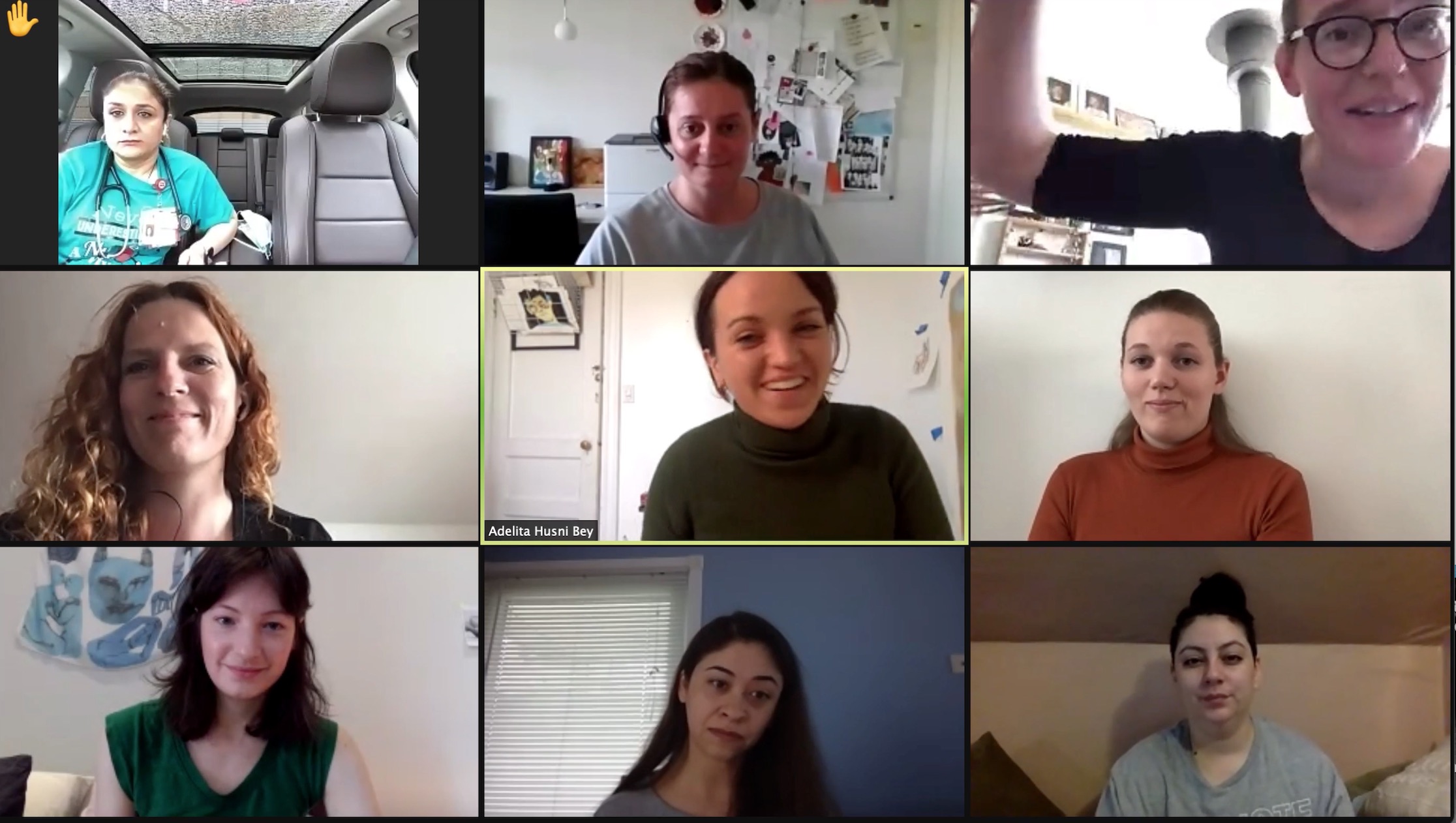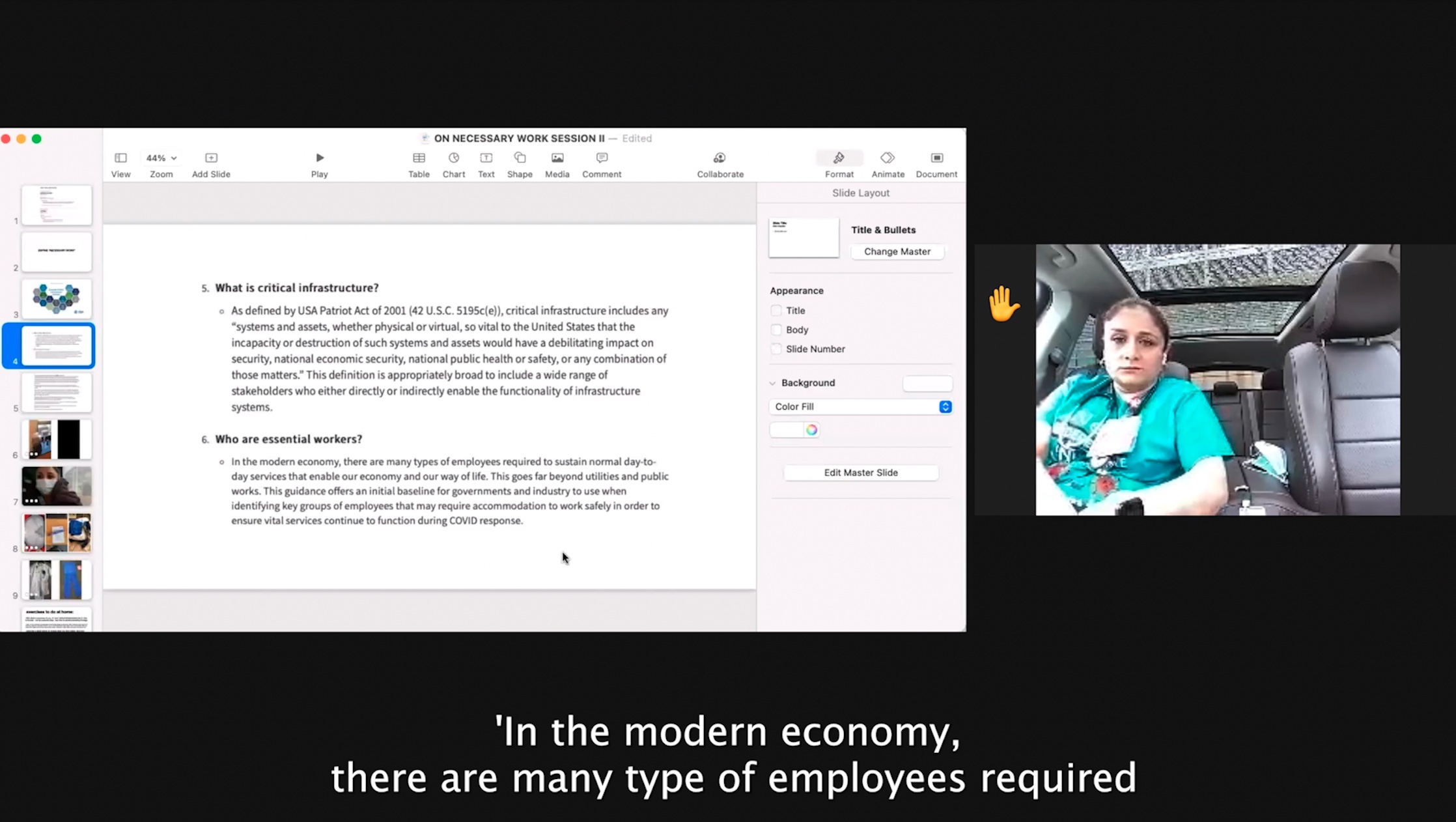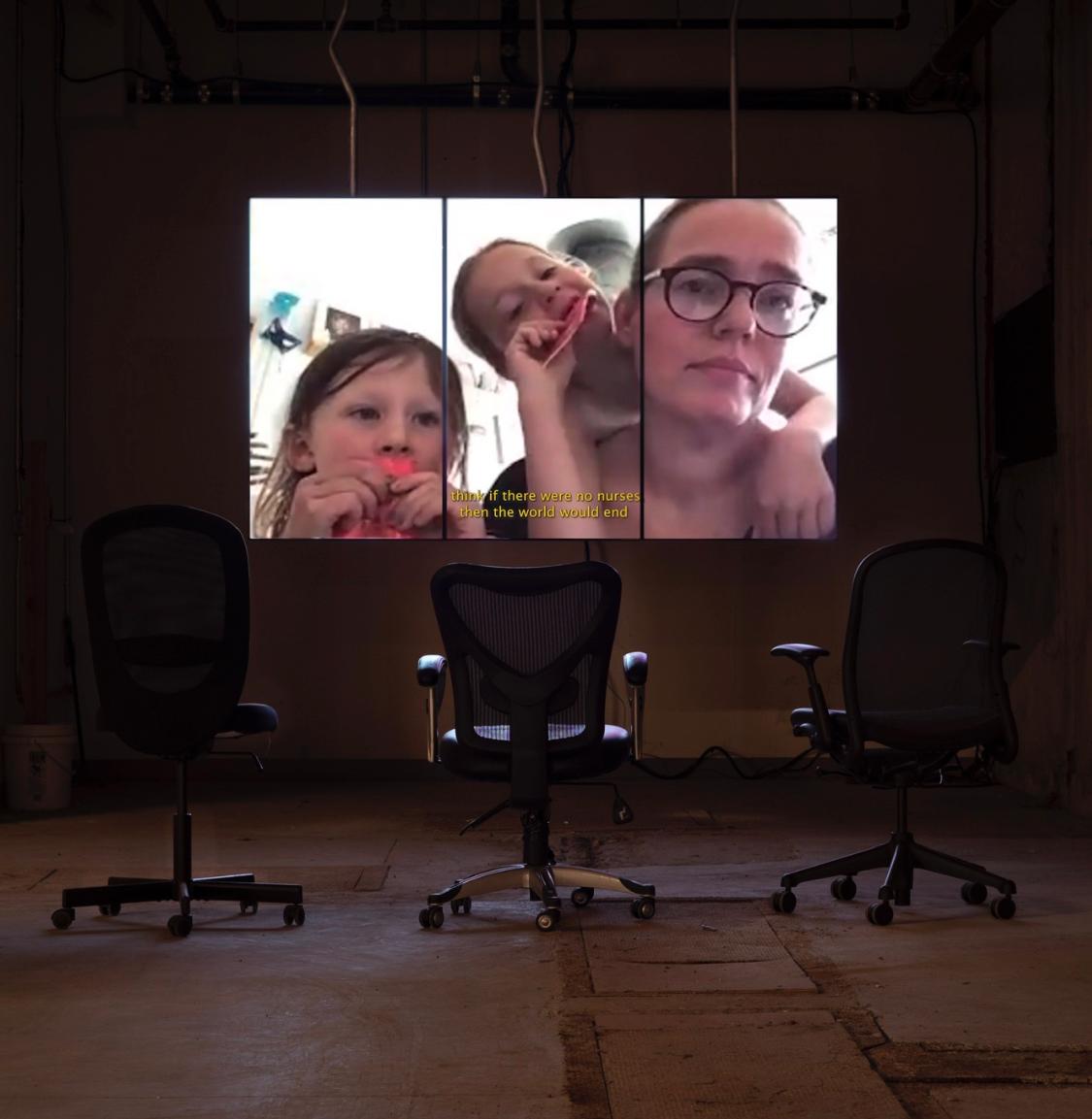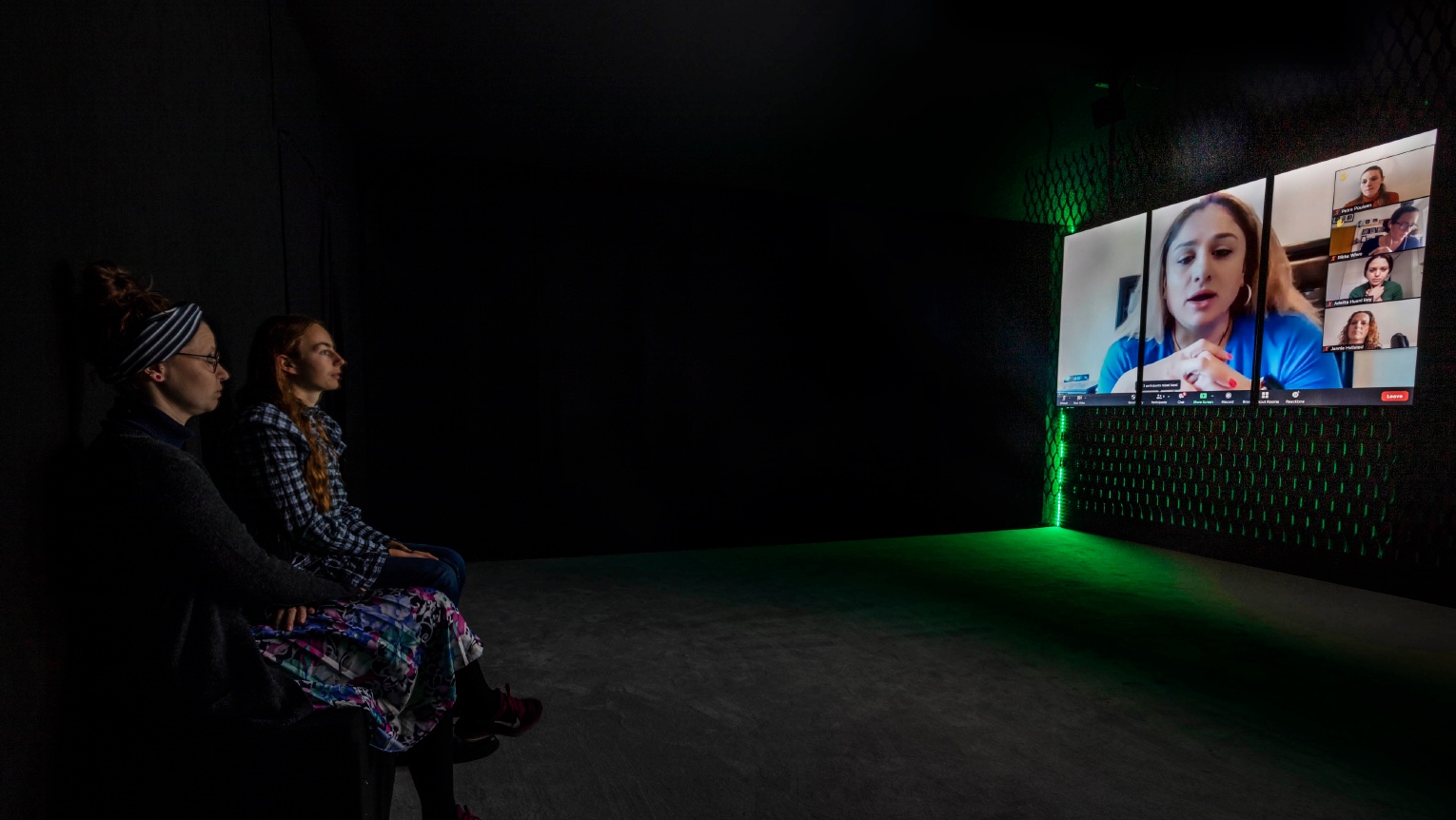On Necessary Work
Asa Mendelsohn
May 2022
Only a minute into On Necessary Work (2021), Consuelo Vargas is getting to the heart of it. She sits in a chair in front of a blue wall, blinds lowered against the daylight. Her eyes move across the room as she speaks: “When nurses come here, what do we expect of them?”1 We may be arriving mid-thought.
Vargas speaks from several positions. At the time of recording, she is a registered nurse of sixteen years, working in the emergency room at John H. Stroger Jr. Hospital of Cook County, the largest hospital in Illinois and the largest public “safety-net” hospital in Chicago serving systematically disenfranchised communities on the city’s South and West Sides.2 As a member and chief steward of National Nurses United, Vargas has helped organize workers against the corporate institutional practices and austere social welfare policies that have made the working conditions at Stroger, as at many hospitals across and far beyond Chicago, increasingly violent.3 On this Zoom call, she is a participant in a workshop convened by artist and pedagogue Adelita Husni Bey.

On Necessary Work, 2021. Zoom and mobile phone footage, 32:44 minutes. Courtesy of Adelita Husni Bey and Galleria Laveronica.
Over six weekends in spring 2021, Adelita Husni Bey met with a cohort of eight unionized healthcare workers based in the US and Denmark for an online filmmaking workshop focused on their experiences working in hospitals throughout the first year of the pandemic. Guided by Husni Bey’s research into historic pandemic protocols, of particular focus for this cohort was the designation of their work as “essential.” How and why is the label “essential worker” brandished as a moralistic sword, as if people working as nurses or custodians or grocery clerks have chosen to sacrifice themselves to a higher order of social good – “remunerated,” as Angela Mitropoulos has reflected, “by applause”4? The workshop and resulting film create a space to ask: What realities of sacrifice, class oppression, and grief does the label “essential” veil?
A year after the workshop with this cohort of nurses, On Necessary Work was installed in the raw basement annex at Brooklyn Army Terminal (BAT), a complex of warehouse buildings in Sunset Park, Brooklyn that were originally built as a military supply base during the 1918 flu pandemic. For several decades the largest military supply base within the US, and more recently a site of mass Covid vaccination and testing, BAT is now managed by the city and leased out to businesses ranging from hyperboloid technology manufacturing and a Ford dealership to a small-batch granola “lab.”5 This is the backdrop for These Conditions, Husni Bey’s Vera List Center Fellowship exhibition (February 8 to April 10, 2022) presenting touchstones, questions, friendships, and associations from her research on pandemics. In one dark corner of this space, On Necessary Work plays on loop: three vertically oriented monitors that hang from the ceiling, together forming a horizontal frame. Mismatched wheeling desk chairs compose audience seating. The mobile, in-process qualities of this design align with the anarcho-collectivist strategies, radical pedagogies, and performance practices from which Husni Bey draws.
On Necessary Work combines mobile phone footage shot by participants in their workplaces and homes with recordings from their conversations on Zoom. Videoconferencing can be a tool for transnational dialogue and exchange that may not be possible otherwise. The branded Zoom grid also comes to signify our collective political alienation: cropped, surveilled, unable to make eye contact. Making a film can be the occasion to gather, but it can also be the occasion to look at yourself, to attempt to peer around the edges of the grid and consider how we look as a group. In the liminal online meeting room, the cohort of healthcare workers exchanges reflections, grievances, and insights that, in the edited film, riff on one another, building toward a collective analysis. They address the conditions that enable exploitation, while also attending to the ways that experiences of exploitation live in workers’ minds and bodies:
The hospital does not provide enough PPE to keep us safe. Worker safety is patient safety. Apart from patients, I had not touched another person for three months. When my water shut off, I could not shower after working with Covid patients all day. Management had no strategy. Even before the pandemic, it was hard to take a lunch break. The healthcare system has been underfunded for centuries. It’s getting worse and worse. You are made to feel guilty for eating lunch. You are made to feel guilty for getting sick yourself. You do not have a minute between patients dying. When I finally hugged a coworker I started crying. I didn’t realize I was crying. When my coworker finally came to me for a hug, I’d forgotten how to embrace her. We are still short-staffed. My family member loves me but they are siding with anti-worker popular opinion when they say things like, “You are a benevolent human, how could you strike when you care so much about your patients?” Hospital management are mocking us when they cheer for nurses. They are holding us hostage. They’re replacing unionized nurses with contract workers. They’re pushing for this assembly line . . . you cannot treat a patient like that.
Sara Ahmed points out that “the word complaint shares the same root with the word plague, ‘to strike, to lament by beating the breast.’”6 As an advocate of complaint, Ahmed listens closely to experiences of institutional harassment. Listening grounds her research methodology, organizing strategy and ways toward transformation or healing from the harm reenacted within social institutions. As she elaborates: “Complaint can be sick speech. A body can be what is stricken.”7 Building on Ahmed’s thinking, the words grief, grievance, and gravity come from the Latin gravare, “to burden,” and from gravis, “heavy, grave.” Loss becomes yours to carry. How might we carry this weight together? At its best, the practice of voicing grievances in union meetings is a generative strategy of complaint: a way to keep asking the question and to keep answering, “Let’s try.” It can feel like there is never enough time. At most jobs, there never is – time for the more imaginative possibilities that live in asking, or for grief. Nurses’ professional intimacy with sickness, death, and dying shapes the particular valences of their grief and grievance, while also engendering their labor in special ways in the moral imaginations of those of us who are not nurses.
What can the creative work of reflection offer amidst the ongoing demands of the job? Edited by Husni Bey in the months following the workshop, the pacing of the film preserves the elliptical quality of grief and grievance shared through screens. Cutting between participants’ reflections and short personal videos, Husni Bey moves us between vertical and horizontal frames, between three channels and one, and between the “Speaker View” and “Gallery View” settings on Zoom. We watch others listen as someone shares. The feeling of an opening emerges with a series of short exercises filmed on mobile phones, following prompts Husni Bey developed for the online workshop. A series of beginnings and endings are also opportunities to breathe: Film for one minute as you arrive at work. Film for one minute at the end of your shift. Another: Film yourself for one minute.

On Necessary Work, 2021. Zoom and mobile phone footage, 32:44 minutes. Courtesy of Adelita Husni Bey and Galleria Laveronica.
Rhythmically, On Necessary Work conveys the start-and-stop of pandemic time. For 32 minutes we move back and forth: 2020, 2021, 2022. Workshop participants share experiences from the first months of Covid and make comparisons between that time and one year later, the workshop’s present tense. As we watch, we may consider where we are now. A percussive score composed by Timothy Daisy announces our movements, tumbling. This is one way that time moves in crisis, “in a zig-zag fashion, back to front, slow-motion molasses to utter haste,” writes Jamieson Webster.8 Institutional time moves on against subjective time, psychic time, leaving sticky tracks.
Back to Consuelo Vargas addressing the room: “When nurses come here, what do we expect of them?” Speaking between past and present, Vargas recalls the arrival of agency nurses amidst staffing shortages in 2020 as marking an early milestone in the pandemic. Staffing shortages in US hospitals precede the pandemic and have been acutely amplified by it; they are the direct result of corporate consolidation within the hospital and healthcare industries. Amidst the pandemic, this has had deadly consequences for both patients and workers in the US, where more than 90 percent of nurses are women.9 (All of the participants in Husni Bey’s workshop are women.) As reported by National Nurses United, among registered nurses who died as a direct result of the first wave of Covid-19 in 2020, 57.7 percent are nurses of color, with Filipinx nurses making up 52.2 percent and Black nurses making up 31.0 percent. For perspective, as of 2020, 24.1 percent of nurses in the US are people of color, while 4.0 percent are Filipinx and 12.4 percent are Black.10 As the report by National Nurses United explains, while these numbers are likely incomplete, the impact of structural racism and sexism within hospitals is clear.
Agency nurses are employed by a third party and may be contracted for specific shifts in a clinic or hospital. They are generally paid a higher hourly rate than those working in full-time staff positions. Non-union jobs without benefits or protections, agency nurse positions are analogous to other temporary, adjunct, or gig positions that functionally divide the working class and, increasingly, sustain all sectors in late capitalism. Registered nurses recognized that management’s decision to bring in more agency nurses during the pandemic reasserted their lack of regard for worker safety or well-being. National Nurses United have asserted that the “hospital industry’s prioritization of profits over patient care” creates “an occupational syndemic (from ‘syn,’ synergy and ‘demic,’ epidemic).”11 Under these policies of austerity, workers’ lives and their physical and mental health are treated as expendable. Vargas remembers thinking back in 2020 that they were in a “freefall.” This is how time moves in crises manufactured by capitalist social institutions: it spills and collapses. Vargas’s words are animated by a percussive clattering.
In one workshop prompt, Husni Bey asks participants to build a tower from small objects of personal significance, gathering items that they may have on hand. “Gather items that are necessary for you, for your nourishment.” A montage of towers: important books, small foods, photographs, and mementos. “Remove one object from the tower and film as the structure falls.” These are small gestures, but something else mounts with the succession of structures built to fall: the pursuit of a collective form. Freefall may be a better word for “crisis.”
In another session, Husni Bey invites the group to read the text of the US Patriot Act. “Patriot” is, it turns out, an acronym for “[Uniting and Strengthening America by] Providing Appropriate Tools Required to Intercept and Obstruct Terrorism Act of 2001.”12 The legislation established in October 2001 defines the “critical infrastructure” across public and private sectors at the federal, state, and local levels needed to maintain and bolster US empire under “terrorist” attack. This is the legal paradigm used to designate “essential workers” in security, utilities, and public health industries as those whose labor goes on amidst emergency, amidst attack. This is the framework used to designate “essential workers” as those whose labor is necessary for the social reproduction that sustains the military. Regardless of personal identification, “essential workers” are patriots on the “frontlines” of global imperialism. This legal precedence grounds our experience in the 2020s, as US governmental offices and industries use an extended war analogy to address public responses to the pandemic – the popular discourse that says we need to “defeat” Covid; we need to “beat” it. Before uniformed military personnel showed up to work at mass vaccination sites, workers in grocery stores, defense, and hospitals were placed on the expansive “frontlines” of America’s Forever War.

On Necessary Work, 2021, film installation. In These Conditions, Brooklyn Army Terminal, February 8–April 10, 2022. Presented by the Vera List Center for Art and Politics. Photo by Adelita Husni Bey, courtesy the Vera List Center.
Experiences among this cohort of healthcare workers span the differences between the healthcare systems in Denmark and the US, the differences between labor laws and unions in these two wealthy Western states. The film addresses some of these differences without seeking to explain or contextualize them. Workshopping the expression “necessary work,” Rikke Wiwe reflects over Zoom, “Is it my necessary or the government’s necessary?” She is speaking from the context of the hospital system in Denmark, where nearly all of the nation’s hospitals are public and are generally much more accessible to residents than hospitals in the US. In Denmark, instances of sickness and death in the first waves of the pandemic have been far lower, and nurses are members of one labor union nationally, Dansk Sygeplejeråd (Danish Nurses Organization), which was established in 1899.13 Yet, even there, as this cohort describes, hospitals increasingly operate under policies of austerity and encroaching privatization. Even there, nurses face a shortage of protective gloves. There are the differences that shape social welfare policy and access, and there are also the experiential differences between any two hospitals in a city, or any two floors of a hospital.
The geographic coordinates of this workshop group are shaped by institutional project support. On Necessary Work was commissioned by Kunsten Museum of Modern Art in Aalborg, Denmark, where the film was shown last year. The work draws from Husni Bey’s research into historical pandemics and their social and political protocols as the recipient of the Vera List Center for Art and Politics’ biennial fellowship, which also provides the context for its presentation in New York, where I first watched the film in February. Husni Bey’s creative and political commitments as a facilitator lead her to bend institutional support at its discursive edges where gathering, listening, and learning become both the material and the work. Accordingly, while On Necessary Work is concerned with building a collective analysis of “essential work” during the pandemic, it is also, and perhaps primarily, a film concerned with process. Over two months, this took the form of what she calls a pedagogical film set where on Tuesday evening sessions closed to the general public she has been developing a new film with a group of “essential worker” participants based in New York.
On other days, Husni Bey used the exhibition space to host public art and theater workshops for youth, poetry readings, a virtual and in-person study group, and performances. A series of open-faced rooms with movable walls and furnishings fill with drawings made by young artists on weekends, stones, and paper props. A stack of librettos accompany a sound installation held within a heavy curtain: Cronaca del Tempo Ripetuto (A chronicle of histories repeating, 2021), the result of a workshop Husni Bey facilitated with OCRA (Chamber Orchestra of Radicondoli), a Tuscany-based, non-hierarchical collective of young musicians who work without a conductor.14 Posters, printed images, and illustrated texts painted and pasted on the temporary walls propose transhistorical echoes: Husni Bey brings the seventeenth-century Italian grave diggers’ rebellion and the fourteenth-century English Peasants’ Revolt into dialogue with the strategies for direct action and mutual support modeled by generations of HIV/AIDS activists and the Movement for Black Lives. It is a dialogue about collective resistance to organized abandonment, that, like On Necessary Work, privileges poetic continuities over linear analysis. A couple of weeks before the exhibition closes, a wall is turned on its side, becoming the platform for a raft. As in the film, within her set, there is room for us to tumble, freefall, suspending ourselves while attempting to peer around the edges of the grid. What happens when we learn to look and to look back as a group?

On Necessary Work, 2021. Film installation, Kunsten Museum of Modern Art, Aalborg, Denmark. Courtesy of Adelita Husni Bey and Galleria Laveronica.
One “On Necessary Work” online study group session in March 2022 features guest speakers Imogen Beynon, Deputy Director at the United Workers Union in Australia, and Consuelo Vargas.15Vargas shares that in the months since the filmmaking workshop in 2021, she’s decided to take a break from working bedside. She is making plans to continue her education and to recover from the past two years. Did participating in the workshop help her come to this decision? Upon learning her update, I think back again to the first minutes of On Necessary Work, as Vargas continues speaking in a blue room. She reflects on those first months of the pandemic in the hospital: “We cannot lose a nurse. That was my goal, was to not lose a nurse. I knew we were going to lose patients, but we had to protect ourselves. And that’s where . . . my thinking was . . .” Her voice breaks at “survival.” She leans back, creating space with her body for someone else to begin.
Footnotes
- On Necessary Work (Adelita Husni Bey with Cady Chaplin, Ninna Ingeborg Christiansen, Falguni Dave, Jannie Elisabeth Asta Hvilsted, Petra Poulsen, Kristen Perez, Consuelo Vargas, Rikke Wiwe, 2021, 32:44 minutes).
- See Elizabeth Lalasz, “‘You Can Find Us in the Break Room’: How Nurses Got Masks,” Labor Notes, April 7, 2020, https://labornotes.org/blogs/2020/04/you-can-find-us-break-room-how-nurses-got-masks; Labor Notes Staff, “Nurses Across the U.S. Protest Dangerous Conditions and For-Profit Health Care,” Labor Notes, April 14, 2020, https://labornotes.org/2020/04/nurses-across-us-protest-dangerous-conditions-and-profit-health-care.
- On June 24, 2021, nurses at Stroger joined healthcare workers across Chicago to carry out a one-day strike. This was amidst contract negotiations as management continued to dismiss nurses’ demands to more safely address staffing shortages, which nurses had been voicing for over two years. See Lalasz, Labor Notes, and Falguni Dave, “Nurses strike Cook County Health for 1 day over staffing concerns,” WGN News Chicago, June 24, 2021.
- Angela Mitropoulos, Pandemonium, Proliferating Borders of Capital and the Pandemic Swerve (London: Pluto Press, 2020), 117, as quoted by Adelita Husni Bey for the “On Necessary Work” study group, 2022.
- About Brooklyn Army Terminal: https://brooklynarmyterminal.com/about.
- Sara Ahmed, Complaint! (Durham, NC: Duke University Press, 2021), 18. She adds that “the root is *plāk, Indo-European, meaning ‘strike.’” Ahmed, 314, n25.
- Ahmed, Complaint!, 18.
- Jamieson Webster, “The Real Real,” in conversation with Alison M. Gingeras, Artforum, May 5, 2020, https://www.artforum.com/slant/jamieson-webster-and-alison-m-gingeras-discuss-psychoanalysis-during-the-pandemic-82992.
- Richard A. Smiley et al, “The 2020 National Nursing Workforce Survey,” Journal of Nursing Regulation 12, no. 1 (April 1, 2021): S1–96, https://doi.org/10.1016/S2155-8256(21)00027-2.
- National Nurses United, “Deadly Shame: Redressing the Devaluation of Registered Nurse Labor Through Pandemic Equity” (2020), https://www.nationalnursesunited.org/sites/default/files/nnu/graphics/documents/1220_Covid19_DeadlyShame_PandemicEquity_WhitePaper_FINAL.pdf, 15.
- National Nurses United, “Workplace Violence and Covid-19 in Health Care: How the Hospital Industry Created an Occupational Syndemic,” (November 2021), 4. Report available at: https://www.nationalnursesunited.org/workplace-violence-and-covid-19-health-care.
- “Uniting and Strengthening America by Providing Appropriate Tools Required to Intercept and Obstruct Terrorism (USA Patriot Act) Act of 2001: An act to deter and punish terrorist acts in the United States and across the globe, to enhance law enforcement investigatory tools, and for other purposes,” 42 U.S.C. 5195(e),https://www.govinfo.gov/content/pkg/PLAW-107publ56/pdf/PLAW-107publ56.pdf, Sec. 1016: “Critical Infrastructures Protection.”
- “Welcome to DNO,” Dansk Sygeplejeråd (Danish Nurses Organization), accessed May 17, 2022, https://dsr.dk/om-dsr/kontakt-dsr/welcome-to-dno.
- A digital version of the printed libretto accompanying this sound work can be accessed at: https://veralistcenter.org/wp-content/uploads/2022/02/TheseConditions_libretto.pdf.
- “On Necessary Work” study group session with Adelita Husni Bey, Imogen Beynon, Alex Martinis Roe, and Consuelo Vargas, online, hosted by the Vera List Center, The New School for Social Research, New York, and the University of Melbourne, March 10, 2022. Video recording accessible at: https://veralistcenter.org/events/necessary-work.
Asa Mendelsohn is an artist, writer, and teacher. A recipient of an Andy Warhol Foundation Arts Writers Grant, he is working on a film and essays about friendship. Recently, Asa has been making media with high school students in New York and teaching gender/sexuality at Guttman Community College, CUNY.